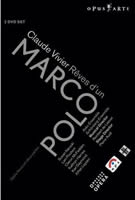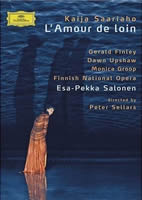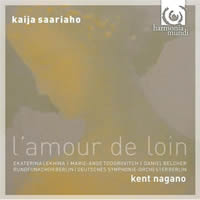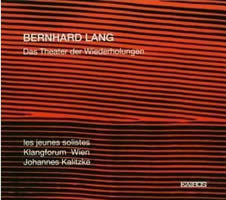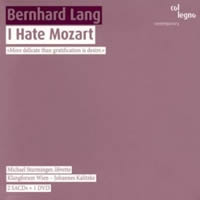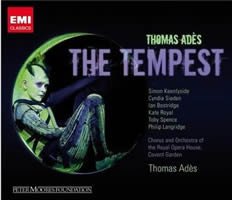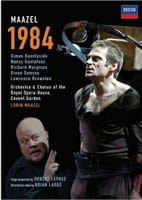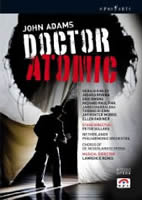Armchair Operas 5.
|
Grant Chu Covell [February 2010.]
“Rêves d’un Marco Polo: Opéra fleuve en deux parties.” Claude VIVIER: Kopernikus: Opéra rituel de mort (1979); Marco Polo (version created by Reinbert de Leeuw and Pierre Audi) consisting of Glaubst du an die Unsterblichkeit der Seele (1983, unfinished), Prologue pour un Marco Polo (1981), Shiraz (1977), Lonely Child (1980), Zipangu (1980) and Wo bist du, Licht! (1981). Cast includes: Susan Narucki, Claron McFadden, Kathryn Harries, Karl Daymond, Johan Leysen. Asko Ensemble, Schönberg Ensemble, Reinbert de Leeuw (cond.). Opus Arte OA 0943 D (2 DVDs) (http://www.opusarte.com/). At first it’s a bit hard to discern what’s on offer here besides Cherry Duyns’ 66-minute composer biography. A pair of DVDs present some of the short-lived Vivier’s most important works in theatrical performances, a two-evening spectacle, Rêves d’un Marco Polo, assembled by de Leeuw and Audi. Disc 1 contains the first night’s program, Vivier’s two-act 64-minute Kopernikus: Opéra rituel de mort. We see an audience hastening to a theatre, thence to the action. Vivier reaches for universal themes and rituals with a bit of Jarry and Stockhausen thrown in for good measure. (Vivier was a Stockhausen student.) For this performance, eight musicians and eight singers who’ve memorized their parts wander about the cluttered space. Everyone is costumed like a disenfranchised Pierrot. I gave up trying to tweeze out a plot or sense of continuity. Disc 2 offers the second evening, Marco Polo, several compositions programmed together. Vivier often employs a homeless adventurer or Marco Polo figure, so the concept makes sense. He was working on Glaubst du an die Unsterblichkeit der Seele before he was murdered. Bizarrely, the work foretells his death. Unlike Kopernikus’ dated haphazardness, Glaubst du’s similar combination of speakers, singers and instrumentalists finds a more distinct language with emphasis on percussion, microtones and non-Western elements reminiscent of Messiaen and Scelsi. The solo-piano Shiraz tempers aggression with weariness. From a slaughtering perpetual motion, the material grows expressive, guarding its power. One of the few wholly original compositions of the 20th century, Zipangu for strings growls and shines. What a shame it is not better known. Lonely Child for soprano and chamber orchestra offers strange harmonies, hesitant melodies and sprouts of Verdian lyricism. Vivier takes some acclimatizing, and this atypical program requires audience investment before yielding.
Kaija SAARIAHO: L’Amour de loin (2000). Cast includes: Gerald Finley, Dawn Upshaw, Monica Groop. Finnish National Opera, Esa-Pekka Salonen (cond.). DG B0004721-09. (1 DVD) (http://www.deutschegrammophon.com/). Kaija SAARIAHO: L’Amour de loin (2000). Cast includes: Daniel Belcher, Ekaterina Lekhina, Marie-Ange Todorovitch. Rundfunkchor Berlin, Deutsches Symphonie-Orchester Berlin, Kent Nagano (cond.). Harmonia Mundi HMC 801937.38 (2 SACDs) (http://www.harmoniamundi.com/). I confess to conflicting reactions to Saariaho’s music. One day it sounds luminescent and magical, the next it’s like wading through a stagnant marsh. L’Amour de loin would be quintessential Saariaho: a languorous base sprinkled with star-like fragments. Sparked by Messiaen’s St. Francis of Assisi, Saariaho’s first opera asserts its French flavor by perpetuating the gloom of Debussy’s Pelléas et Mélisande. There are also echoes of Islamic Spain — I envisioned the Alhambra. Saariaho’s palette embraces electronics and recorded sound realized at IRCAM. Based on the true story of Jaufré Rudel, a 12th-century troubadour, Amin Maalouf’s libretto swirls opposites: dreams/reality, East/West, physical/spiritual love. The action requires three principals. Set in the age of the Crusades, Rudel, Prince of Blaye, pursues ideal love while Clémence, Countess of Tripoli, longs for her French birthplace. An itinerant pilgrim tells each of the other. Rudel falls in love with Clémence and journeys across the seas to meet her. Clémence wrestles with conflicting emotions as Rudel nearly worries himself to death en route. Finally meeting, Rudel expires after the couple declares their love, with Clémence finding solace in God. Amen. DG’s 2005 release captures Finley and Upshaw reprising their Salzburg Festival premiere roles as Rudel and Clémence. Groop sang the Pilgrim in the first American presentation. The Finnish production employs the same Salzburg sets and costumes, narrow metallic circular staircases and a stage covered in water. Without knowing Salonen’s release, Nagano’s production would be quite convincing, even though many of Lekhina’s arias suffer from a light echo. DG’s version offers greater sonic variety. Finley and Upshaw caress their lines, and Salonen knows what to do with his compatriot’s music, ably alternating menace and tranquility mid-measure.
Bernhard LANG: Das Theater der Wiederholungen (2000-02). Cast includes: Renate Wicke, Anna Maria Pammer, David Cordier, Martin Wölfel, Alfred Werner, Ekkehard Abele. Les jeunes solistes, Klangforum Wien, Johannes Kalitzke (cond.). Kairos 0012532KAI (2 CDs) (http://www.kairos-music.com/). Distributed in the US by Allegro Music (http://www.allegro-music.com/). Bernhard LANG: I Hate Mozart (2006). Cast includes: Florian Boesch, Dagmar Schellenberger, Andrea Lauren Brown, Salome Kammer, Mathias Zachariassen, David Pittmann-Jennings, Rupert Bergmann. Dieter Kovacic, Wolfgang Fuchs (turntables), Peter Böhm (sound dir.), Vokalensemble NOVA, Klangforum Wien, Johannes Kalitzke (cond.). col legno WWE 2 SACD + DVD 20277 (2 SACDs, 1 DVD) (http://www.col-legno.com/). Distributed in the US by Allegro Music (http://www.allegro-music.com/). Despite familiarity with Lang’s music, I find Das Theater der Wiederholungen (“The Theatre of Repetitions”) tough going. In three tales, texts stutter and stagger over dissonant shards. Sung phrases devolve into repeated syllables, grammar dissolves into nonsense. The first tale, in French, employs texts by Huysmans and Sade. The second tale’s English comes from William S. Burroughs’ The Place of Dead Roads. The German third exploits Nuremburg trial transcripts and concentration camp documents. Lang paints a bleak picture. The repetitive style and highbrow content foster alienation, though Kalitzke, the soloists and Klangforum Wien make it all seem quite natural. I Hate Mozart is a treat. Where Das Theater der Wiederholungen is arcane, I Hate Mozart would fit quite comfortably amidst checkout-counter glossies. Michael Sturminger’s plot spoofs an opera troupe’s attempt at staging Die Zauberflöte, hating the effort and most of all Mozart for laying bare their inadequacies. Among the lovely absurdities, singers play inflated, egotistical versions of themselves, and the conductor (Boesch) delivers an absurd monologue while beating time. Schellenberger makes a great diva, and Pittmann-Jennings is letter-perfect as an agent. The clever sets include backstage practice rooms, an orchestra pit, hotel rooms and the theater’s canteen. Wee bits of Mozart filter through repeated passages and electronic loops. Kalitzke and Klangforum Wien seem to have made Lang a specialty. I’m eager for more.
Thomas ADÈS: The Tempest (2004). Cast includes: Simon Keenlyside, Cyndia Sieden, Ian Bostridge, Kate Royal, Toby Spence, Philip Langridge. The Royal Opera Chorus, The Orchestra of the Royal Opera House, Covent Garden, Thomas Adès (cond.). EMI 50999 6 95234 4 7 (2 CDs) (http://www.emiclassics.com/). I’ve tried to like the talented Adès, the UK’s favorite wunderkind, but find his work inconsistent and often overbearing. His various EMI releases contain at least one memorable item each. The Americas disc (EMI 7243 5 57610 2 6) features a captivating arrangement of Couperin’s Les Barricades Mystérieuses, suggesting that Adès actually has a soul. The Tempest plays as coolly mature, and yet the plot’s inherent complexity makes for difficult going. Meredith Oakes abridged Shakespeare’s original, doing mild violence to a number of familiar lines, e.g., “full fathom five” becoming “five fathoms deep.” Adès’ palette declares no particular stylistic allegiance. As Ariel, Sieden’s supremely high coloratura part may well provoke distracting wonderment. Balancing the gruff dissonance and a Turangalîla-like rhythmic energy are gorgeous tonal passages, as in Bostridge’s Caliban explaining the island’s mysteries to the shipwrecked court. This 2007 Covent Garden production is a revival of the original 2004 premiere. Last year, the Metropolitan Opera announced The Tempest would be part of its 2012-13 year. I am sure a DVD release will, at the very least, help identify distracting stage noises. I plan to give it another try in NYC.
Lorin MAAZEL: 1984 (2005). Cast includes: Simon Keenlyside, Nancy Gustafson, Richard Margison, Diana Damrau, Lawrence Brownlee, Jeremy White, Graeme Danby, Mary Lloyd-Davies, Johnnie Fiori. The Demon Barbers, Orchestra and Chorus of the Royal Opera House, Covent Garden, Lorin Maazel (cond.). Decca 074 3289 (2 DVDs) (http://www.decca.com/). J.D. McClatchy and Thomas Meehan’s libretto is based on Orwell’s novel. With a powerful story, fine singers, bold visuals and good orchestra, what could go wrong? Let’s start and finish with Maazel’s unmemorable music. Strategically placed tonal anthems and retro-folk tunes notwithstanding, the soundtrack looks with lame effect to Berg, Britten and Shostakovich. Some supporting roles are effective: Damrau as a morning gym instructor and later a drunken prostitute, Brownlee and White as the lead’s colleagues. While Keenlyside and Gustafson labor valiantly as the doomed lovers Winston and Julia, the opera’s scaffolding simply doesn’t support them. Does it really matter that Maazel covered some of the production costs? Some reviewers came down hard on what they saw as a vanity enterprise. A bonus feature offers Maazel’s illustrated synopsis.
John ADAMS: Doctor Atomic (2005). Cast includes: Gerald Finley, Jessica Rivera, Eric Owens, Richard Paul Fink, James Maddalena, Thomas Glenn, Jay Hunter Morris, Ellen Rabiner. Chorus of De Nederlandse Opera, Netherlands Philharmonic Orchestra, Lawrence Renes (cond.). Opus Arte OA 0998 D (2 DVDs) (http://www.opusarte.com/). Distributed in the US by Naxos (http://www.naxos.com/). Given that an opera about the atomic bomb has every right to be deadly serious, Peter Sellars’ pretentiously heavy hand fashions a maudlin entity. Finley is fine as the obdurate Oppenheimer, yet, like all the other characters, his arrogance and anxiety soon become wearying. Adams’ writing migrates between a gray slushiness and unrelenting hectoring. Is the distracting choreography meant to remind us that this is Art? I had not expected to be disappointed. Forgive an easy cliché: Doctor Atomic bombs.
[Previous Article:
Album Tweets 6.]
[Next Article:
Second Appeal for Support for IMEB]
|
